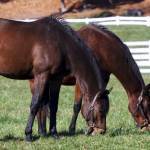Battling Pasture-Associated Laminitis in Horses

Imagine your horse was continually at risk for developing laminitis, repeatedly suffering from hoof soreness. Chances are, you would jump at every opportunity to minimize or eliminate future bouts, including the use of forage analysis to help create an appropriate diet.
“Analyzing hay or pasture can determine the amount of water-soluble carbohydrates, or WSCs, in forage. Researchers believe WSCs contribute to the development of pasture-associated laminitis in certain horses,” explained Kathleen Crandell, Ph.D., a Kentucky Equine Research nutritionist.
Water-soluble carbohydrates is a collective term for simple sugars and fructans. When WSCs reach the hindgut and undergo fermentation, they produce lactic acid, which decreases the pH of the hindgut and contributes to acidosis, potentially leading to laminitis.
While soaking hay reduces the WSC content, a more scientific approach involves having hay analyzed by a laboratory. In fact, hay analysis is the only way to estimate WSC content at the present time.
“Horse owners send a representative sample of their hay to a laboratory to ensure they are offering forage containing less than 10% WSC, as this minimizes the chances of laminitis,” noted Crandell.
Not all laboratories use identical protocols to measure WSCs, and the exact type or amount of WSCs capable of inducing laminitis remains unclear. Further, several factors impact the WSC content of forage, including grass species, climate, time of day, season, and rainfall.
To improve the science of hay analysis and to better serve owners of horses at risk of laminitis, a Kentucky-based research team investigated the process of hay analysis, comparing methodologies, type of hay, and sampling time.*
The researchers found that methodology strongly affected results, suggesting that standardized protocols should be developed. Further, the exact component of the WSCs—monosaccharides such as glucose, disaccharides such as sucrose, and fructans—that contribute to the development of pasture-associated laminitis still need to be identified.
“The researchers also pointed out that, because the WSC content of various grass hays is likely species-specific, a database containing the precise WSC content of each type of hay might provide a valuable management tool for horses at risk of pasture-associated laminitis,” Crandell shared.
While researchers continue to determine the best way to analyze hay and to identify the factors responsible for pasture-associated laminitis, nutritionists continue to recommend best-management practices.
“Owners may wish to supplement at-risk horses with KER’s EquiShure, a time-released hindgut buffer that prevents decreases in pH associated with rapid starch and sugar fermentation after a large grain meal or fructan exposure,” Crandell said. “EquiShure has been a game-changer for many laminitis-prone horses.”
Kentucky Equine Research also offers Bio-Bloom PS (Bio-Bloom HF in Australia), a nutritional supplement containing key nutrients for hoof health, including biotin, methionine, iodine, and chelated zinc.
*Kagan, I.A., L.M. Lawrence, D.H. Seman, et al. 2018. Effects of sampling time, cultivar, and methodology on water- and ethanol-soluble carbohydrate profiles of three cool-season grasses in central Kentucky. Journal of Equine Veterinary Science. 61:99-107.








